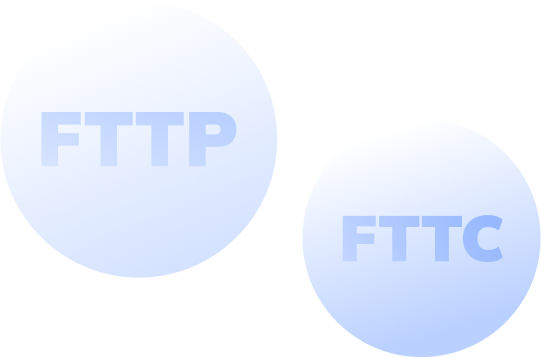FTTC vs FTTP Guide
Choosing the right business broadband connection can be confusing due to the many acronyms and technologies available. Here's a guide to help you decide.

FTTC vs FTTP - The Differences
|
Feature |
Fibre to the Cabinet (FTTC) |
Fibre to the Premises (FTTP) |
|
Technology |
Fibre cables to the cabinet and then copper to the premises. |
Fibre cables all the way to your premises. |
|
Speeds |
Up to 76 Mbps. |
Up to 1,600 Mbps. |
|
Cost |
Typically cheaper as a basic broadband. |
Can be more expensive but faster speeds. |
|
Reliability |
Speeds vary depending on the distance from the cabinet. |
Fibre cables retain higher speeds. |
|
Great For |
Basic browsing and emails |
Payment systems, cloud services and video calls. |
What Is FTTC Broadband?
Fibre to the Cabinet (FTTC) broadband is widely available in the UK and can deliver download speeds of up to 76 Mbps. However, during peak usage hours, speeds can fluctuate significantly, particularly if you are far from the street cabinet.
While FTTC may not be as fast or reliable as full-fibre FTTP broadband, it can meet the needs of some users.
How Does FTTC Work?
FTTC connections are enabled by fibre optic cables running from the exchange to the nearest street cabinet. From there, the signal is split, and copper cables transmit the connection to your property.
However, copper cabling transmits data at slower speeds and is less effective over long distances compared to full-fibre.

What Are The Benefits of FTTC Broadband?
- Good availability across the UK.
- Better speeds than its ADSL predecessor.
- One of the cheapest business broadband solutions.
- Pretty reliable for a basic connection.
What Are The Disadvantages of FTTC Broadband?
- Speed fluctuates during usage and how far from the street cabinet you are.
- Not as fast as full-fibre connection (FFTP).
- Must include a line rental.
- This will only last until 2027 as the PSTN network will be switched off.
What Is FTTP Broadband?
Fibre to the Premises (FTTP), commonly referred to as full-fibre broadband, utilises fibre optic cables to deliver your internet connection directly to your premises. While not available everywhere in the UK, FTTP is being rapidly rolled out.
How Does FTTP Work?
FTTP connections utilise fibre cabling that runs from the exchange directly to your home, resulting in significantly faster and more reliable internet speeds. Since the connection travels through fibre optic cables, it is less affected by the performance limitations of copper wiring.

What Are The Benefits of FTTP Broadband?
- Provides faster upload and download speeds.
- Much more reliable due to weather-resistant fibre cables.
- FTTP offers a more secure connection.
- This connection is not impacted by the PSTN switch-off.
What Are The Disadvantages of FTTP Broadband?
- Can be more expensive than other broadband options.
- You may need to pay for installation depending on location.
- Full fibre may not be available in your area yet.
- Some businesses may need greater speeds and reliability.
How To Switch To FTTP Broadband?
-
 SwitchGet Started
SwitchGet StartedOnce you find a deal you like, we’ll manage the entire switching process for you and keep you updated along the way.

Can I Upgrade to FTTP Broadband?
As full-fibre networks are being expanded across the UK, some areas may not yet have access. You can use broadband comparison tools to explore available deals in your area and see if an upgrade to FTTP broadband is possible.
Not sure which deal is right for you? Read our Business Broadband Buyer’s Guide for help choosing.

